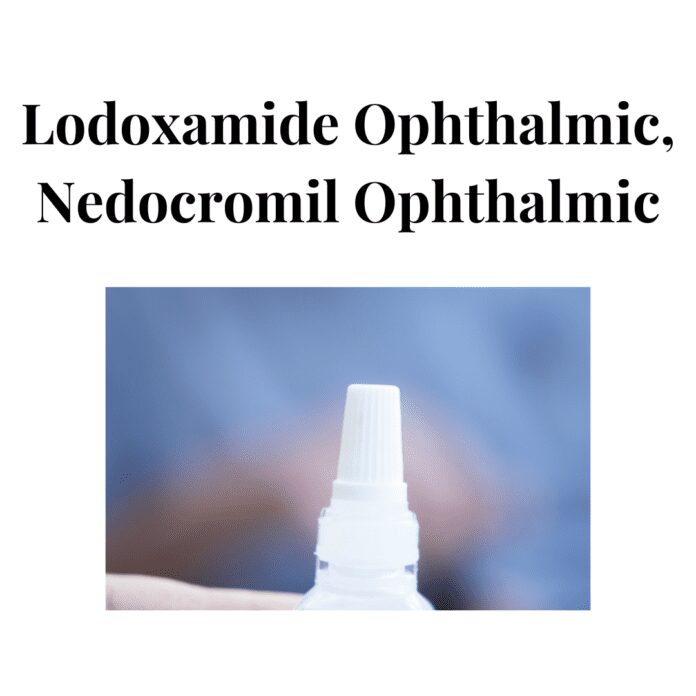Uses
Lodoxamide ophthalmic and nedocromil ophthalmic are used to treat itchy eyes caused by allergies. Symptoms of allergies occur when cells in your body called mast cells to release substances after you come in contact with something to which you are allergic. Nedocromil is in a class of drugs called mast cell stabilizers. It works by stopping the release of these substances
Side Effects Of Lodoxamide Ophthalmic And Nedocromil Ophthalmic
Lodoxamide ophthalmic and nedocromil ophthalmic may cause side effects. Tell your doctor if any of these symptoms are severe or do not go away:
- stinging or burning of the eyes
- blurred vision
- increased eye redness or itching
Warnings & Precautions
Before using lodoxamide ophthalmic and nedocromil ophthalmic:
- tell your doctor and pharmacist if you are allergic to nedocromil or any other medications.
- tell your doctor and pharmacist what prescription and nonprescription medications you are taking, including vitamins or herbal products.
- tell your doctor if you wear contact lenses; you should not wear contact lenses while your eyes are itchy and red due to allergies.
Dosage Of Lodoxamide Ophthalmic And Nedocromil Ophthalmic
Lodoxamide ophthalmic and nedocromil ophthalmic comes as a solution (liquid) to instill in the eyes. It is usually instilled twice daily. Follow the directions on your prescription label carefully, and ask your doctor or pharmacist to explain any part you do not understand. Use lodoxamide ophthalmic and nedocromil ophthalmic exactly as directed. Do not use more or less of it or use it more often than prescribed by your doctor.
Your allergy symptom (itchy eyes) should improve when you instill the eye drops. If your symptoms do not improve or they worsen, call your doctor.
Continue to use lodoxamide ophthalmic and nedocromil ophthalmic even if your eyes feel better. Continue to use it until you are no longer exposed to the substance that causes your symptoms, allergy season is over, or your doctor tells you to stop using it.
To instill the eye drops, follow these steps:
- Wash your hands thoroughly with soap and water.
- Check the dropper tip to make sure that it is not chipped or cracked.
- Avoid touching the dropper tip against your eye or anything else; eye drops and droppers must be kept clean.
- While tilting your head back, pull down the lower lid of your eye with your index finger to form a pocket.
- Hold the dropper (tip down) with the other hand, as close to the eye as possible without touching it.
- Brace the remaining fingers of that hand against your face.
- While looking up, gently squeeze the dropper so that a single drop falls into the pocket made by the lower eyelid. Remove your index finger from the lower eyelid.
- Blink your eye a few times to help spread the lodoxamide ophthalmic and nedocromil ophthalmic over your entire eye.
- Close your eye for 2 to 3 minutes and tip your head down as though looking at the floor.
- Place a finger on the tear duct and apply gentle pressure.
- Wipe any excess liquid from your face with a tissue.
- If you are to use more than one drop in the same eye, wait at least 5 minutes before instilling the next drop.
- Replace and tighten the cap on the dropper bottle. Do not wipe or rinse the dropper tip.
- Wash your hands to remove any medication.
Other
Keep all appointments with your doctor.
Do not let anyone else use your medication. Ask your pharmacist any questions you have about refilling your prescription of lodoxamide ophthalmic and nedocromil ophthalmic.
It is important for you to keep a written list of all of the prescription and nonprescription (over-the-counter) medicines you are taking, as well as any products such as vitamins, minerals, or other dietary supplements. You should bring this list with you each time you visit a doctor or if you are admitted to a hospital. It is also important information to carry with you in case of emergencies.
Source
All information has been provided courtesy of MedLinePlus from the National Library of Medicine and from the FDA.



